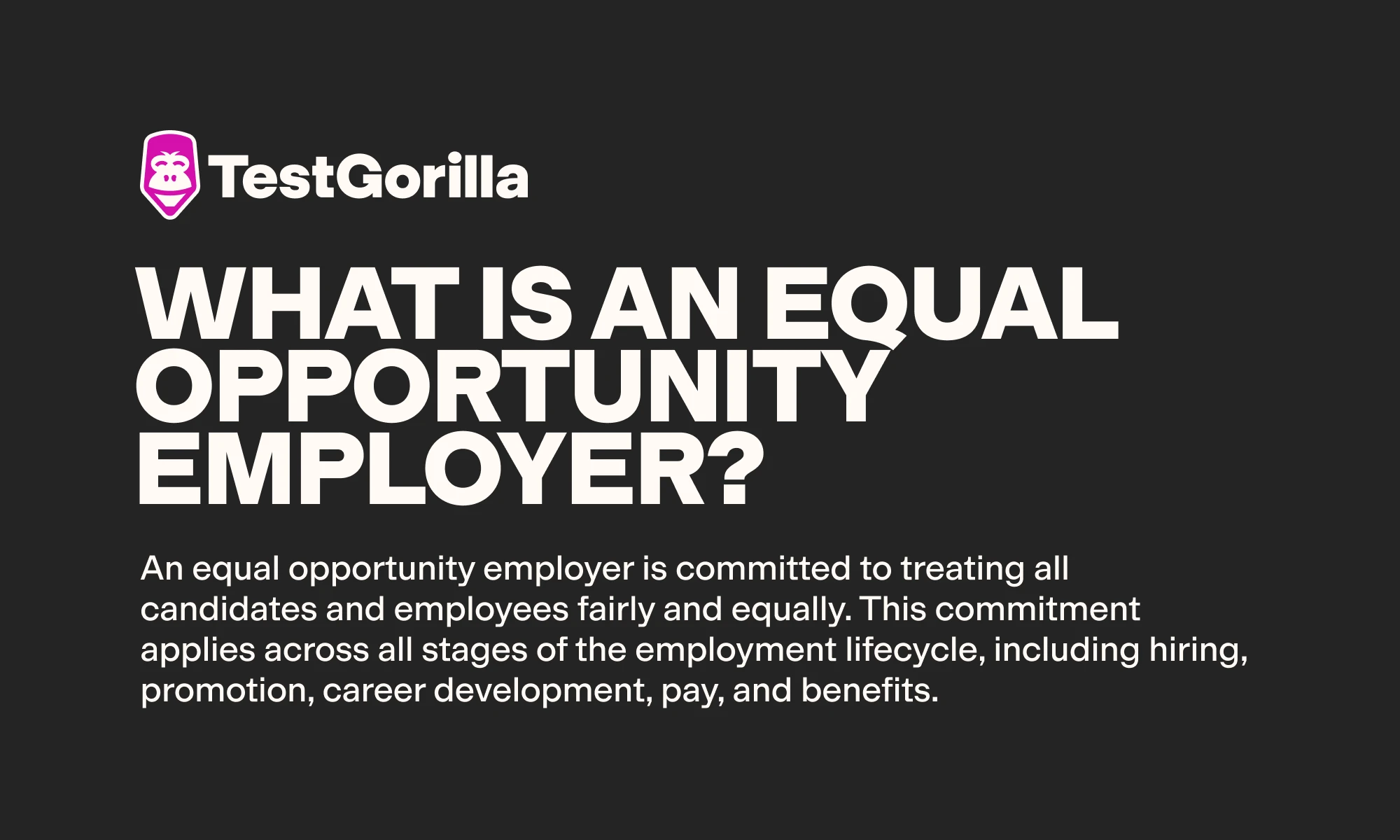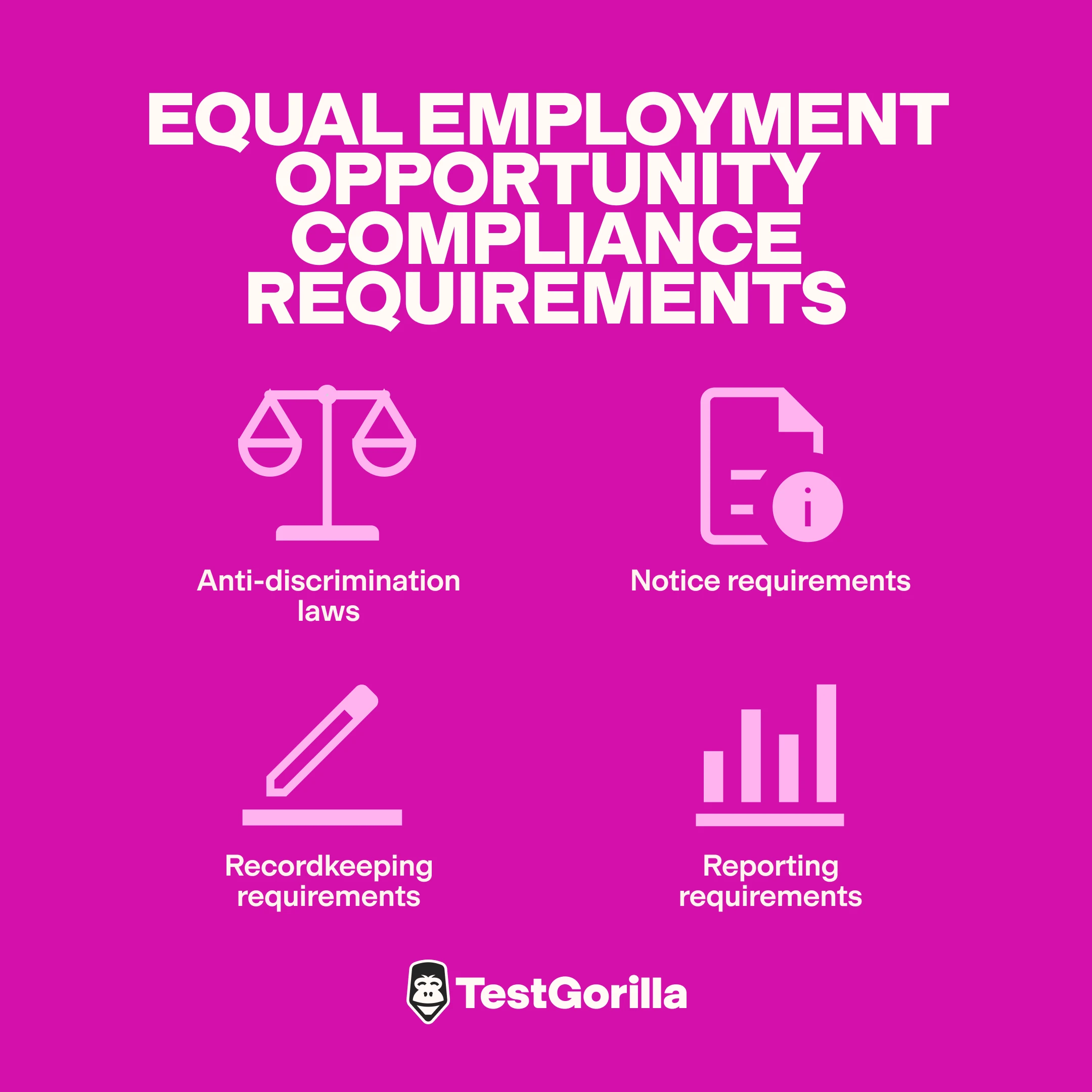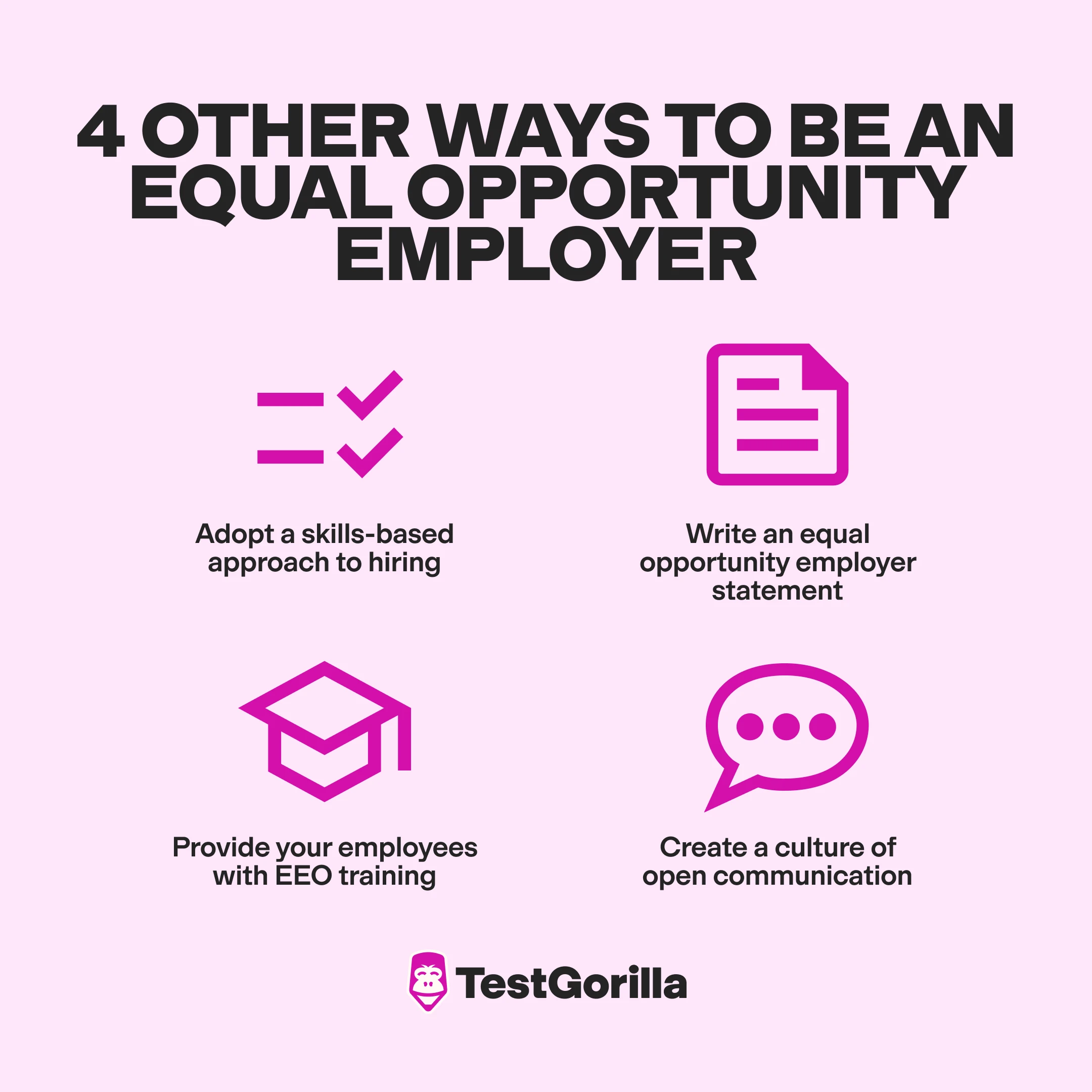Being an equal opportunity employer is crucial to attracting top talent and avoiding costly legal issues. However, knowing where to start when navigating your obligations and creating a fair and inclusive workplace can be challenging.
To help you out, we’ve created this guide to being an equal opportunity employer, including the laws you need to know and strategies you can start implementing today.
Key takeaways
An equal opportunity employer ensures candidates and employees are treated fairly and equally.
The most crucial aspect of being an equal opportunity employer is complying with anti-discrimination laws that apply to your business, including recordkeeping and reporting requirements.
Other ways to foster a fair and inclusive workplace include adopting a skills-based approach to hiring, developing an equal opportunity employer statement, and delivering employee training.
What does “equal opportunity employer” mean?
An equal opportunity employer is committed to treating all candidates and employees fairly and equally. This commitment applies across all stages of the employment lifecycle, including hiring, promotion, career development, pay, and benefits.
Equal opportunity employers:
Don’t discriminate against individuals based on personal characteristics like race, gender, age, or disability.
Ensure everyone has equal access to employment opportunities, regardless of their background or circumstances.
Comply with equal opportunity laws and regulations.
Actively promote a workplace culture that supports diversity, equity, and inclusion (DEI).
All workplaces should strive to be equal opportunity employers. If you don’t, your business may miss out on the benefits of workplace diversity, damage brand identity, and face discrimination complaints and lawsuits.
The best insights on HR and recruitment, delivered to your inbox.
Biweekly updates. No spam. Unsubscribe any time.
Equal employment opportunity compliance: Guidance and tips
The most crucial aspect of being an equal opportunity employer is to comply with your legal obligations. Below, we offer practical guidance on how you can do this.
Anti-discrimination laws
There are various federal and state equal employment opportunity (EEO) laws in the US. Here are the key federal laws that may apply to your business:
Title VII of the Civil Rights Act prohibits employers from discriminating against candidates or employees based on race, color, national origin, religion, and sex (including sexual orientation, pregnancy, gender, and gender identity).
Age Discrimination in Employment Act (ADEA) bans employment discrimination against individuals 40 years and older.
Americans with Disabilities Act (ADA) requires employers not to discriminate against candidates or employees based on a disability. Employers must also make reasonable accommodations for workers with disabilities unless doing so would cause the business undue hardship.
Equal Pay Act (EPA) states that men and women must be paid the same for equal work.
Genetic Information Nondiscrimination Act (GINA) prohibits employers from discriminating against candidates or employees based on their genetic information.
Pregnant Workers Fairness Act (PWFA) requires employers to make reasonable accommodations for pregnancy or childbirth. Employers also can’t discriminate against an employee who requests a reasonable accommodation.
The Equal Employment Opportunity Commission (EEOC) is the federal agency that enforces these anti-discrimination laws.
Most of these laws apply to employers with 15 or more employees, except for the ADEA, which covers businesses with at least 20 employees, and the EPA, which applies to all employers.
Even if these laws don’t apply to your business, following their guidelines can help you become an equal opportunity employer.
In addition to federal laws, many states also have their own anti-discrimination laws. State laws may offer broader protections than federal law – for example, by identifying more protected classes or applying to small business employers.
It’s essential that you seek legal advice about your obligations as an equal opportunity employer at both the federal and state levels.
Notice requirements
If you’re covered by federal anti-discrimination laws, you must display equal opportunity posters in the workplace. These posters inform employees of their rights under federal anti-discrimination laws.
Recordkeeping requirements
Federal anti-discrimination law also has recordkeeping requirements.
Under these, you must keep:
Personnel and employment records for at least one year.
Payroll records, including employee benefit plans, for at least three years (relevant to the ADEA and EPA).
Any records that justify pay differences for male and female employees doing the same job for at least two years.
The EEOC can ask for these records if it investigates your business.
Reporting requirements
Some employers must also file annual EEO-1 reports with the EEOC. If you’re a private employer, this requirement applies if your business:
Is covered by Title VII of the Civil Rights Act and
Has 100 or more employees.
There are separate criteria for federal contractors.
An EEO-1 report contains anonymous workforce demographic information, including gender, race, ethnicity, and job categories.
This data is shared between public agencies and published online by the EEOC for transparency. The EEOC also uses the data to identify possible instances of discrimination to investigate.
The EEOC announces the deadline for filing EEO-1 reports each year, and you can file them online.
4 other ways to be an equal opportunity employer
1. Adopt a skills-based approach to hiring
One of the best ways to support equal opportunity hiring is to introduce a skills-based approach. By prioritizing candidates’ skills, you can reduce the risk of unconscious bias and discrimination in decision-making.
Pre-employment testing is an excellent tool for supporting fair hiring practices. It allows you to objectively assess candidates’ skills, helping minimize the impact of unconscious bias on the hiring process. Plus, platforms like TestGorilla are specifically designed to comply with EEO laws.
Some other skills-based hiring strategies you can use alongside skills testing include:
Blind hiring, where candidates’ identifying information, like age and gender, is removed from their resumes.
Skills-based job descriptions with inclusive language, such as using “they” to refer to candidates rather than “he” or “she.”
Structured interviews, where the panel asks all candidates the same or similar questions.
2. Write an equal opportunity employer statement
An equal opportunity employer statement briefly describes your organization’s commitment to EEO practices in job postings and on your careers page.
For instance, here’s Airbnb’s equal opportunity employer statement:
Airbnb values diversity & belonging and is proud to be an Equal Employment Opportunity employer. All individuals seeking employment at Airbnb are considered without regard to race, color, religion, national origin, age, sex, marital status, ancestry, physical or mental disability, veteran status, gender identity, sexual orientation, or any other legally protected characteristic.
Only federal contractors must use equal opportunity employer statements by law. However, having one is good practice, even if it’s not legally necessary. A statement is a public declaration of your company’s EEO values, demonstrating a willingness to be held accountable.
Remember that while equal opportunity employer statements are important, backing them up with clear policies, strategies, and actions to avoid diversity washing is crucial.
3. Provide your employees with EEO training
Educate your employees about equal opportunity principles and how to apply them to their work. This training should cover topics like:
EEO laws.
Adverse/disparate impact (policies and processes that appear neutral but, in fact, have a discriminatory effect on a particular group).
Unconscious bias.
Ensure you provide training to all employees, from entry-level to C-suite, with a particular focus on HR teams.
You can either bring in an external trainer or develop your own training program. As a starting point, the EEOC offers some basic tips for delivering employee training. Incorporate the training into your onboarding and make it an annual requirement for all employees.
4. Create a culture of open communication
Employees need to feel comfortable raising their concerns if they believe they or someone else is being treated unfairly. This allows you to review and respond immediately to the situation before it escalates.
To encourage open communication, develop clear policies for EEO standards in your organization, in addition to reporting and addressing concerns.
Encourage employee feedback on equal opportunity issues. Set up a way for your workers to provide anonymous feedback, for example, via an online survey.
TestGorilla supports equal opportunity hiring
Becoming an equal opportunity employer involves providing potential and current employees with a fair and inclusive experience. An important starting point to do this is by complying with any anti-discrimination laws that apply to your business.
Using strategies and tools like skills-based hiring and skills testing will ensure hiring fairness and help attract a talented and diverse workforce.
Learn more about how TestGorilla can help you create a more equitable hiring practice, and then try it for free!
FAQs
What’s the difference between EEO and EEOC?
EEO refers to equal employment opportunity and typically relates to a business’s internal equal opportunity policies and procedures. In contrast, the Equal Employment Opportunity Commission is the federal body that enforces employment anti-discrimination laws.
How do you show equal opportunity in the workplace?
To show you are committed to equal opportunity as an employer, you can implement policies, procedures, and strategies like establishing a DEI training program, using blind recruitment practices, adopting a skills-based approach, and creating an environment of transparency and accountability.
Disclaimer
The information in this article is a general summary for informational purposes and is not intended to be legal advice. Laws are subject to constant change, and their application varies based on your individual circumstances. You should always seek legal advice from a qualified attorney about your legal obligations as an employer. While this summary is intended to be informative, we cannot guarantee its accuracy or applicability to your situation.
You've scrolled this far
Why not try TestGorilla for free, and see what happens when you put skills first.





















